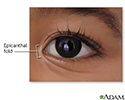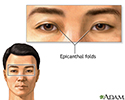Epicanthal folds
Plica palpebronasalis
An epicanthal fold is skin of the upper eyelid that covers the inner corner of the eye. The fold runs from nose to the inner side of the eyebrow.
Causes
Epicanthal folds may be normal for people of Asiatic descent and some non-Asian infants. Epicanthal folds also may be seen in young children of any race before the bridge of the nose begins to rise.
However, the may also be due to certain medical conditions, including:
- Down syndrome
- Fetal alcohol syndrome
-
Turner syndrome
Turner syndrome
Turner syndrome is a rare genetic condition in which a female does not have the usual pair of 2 X chromosomes.
Read Article Now Book Mark Article -
Phenylketonuria
(PKU)
Phenylketonuria
Phenylketonuria (PKU) is a rare condition in which a baby is born without the ability to properly break down an amino acid called phenylalanine....
 ImageRead Article Now Book Mark Article
ImageRead Article Now Book Mark Article -
Williams syndrome
Williams syndrome
Williams syndrome is a rare disorder that can lead to problems with development. It is passed down in families (inherited).
 ImageRead Article Now Book Mark Article
ImageRead Article Now Book Mark Article -
Noonan syndrome
Noonan syndrome
Noonan syndrome is a disease that can be passed down through families (inherited). It causes many parts of the body to develop abnormally.
 ImageRead Article Now Book Mark Article
ImageRead Article Now Book Mark Article -
Rubinstein-Taybi syndrome
Rubinstein-Taybi syndrome
Rubinstein-Taybi syndrome (RTS) is a genetic disease. It involves broad thumbs and toes, short stature, distinctive facial features, and varying deg...
 ImageRead Article Now Book Mark Article
ImageRead Article Now Book Mark Article - Blepharophimosis syndrome
Home Care
In most cases, no home care needed.
When to Contact a Medical Professional
This trait is most often found before or during the first well-baby exam. Call your health care provider if you notice epicanthal folds on your child's eyes and the reason for their presence is unknown.
What to Expect at Your Office Visit
The provider will examine the child and ask questions about the medical history and symptoms. Questions may include:
- Do any family members have Down syndrome or other genetic disorder?
-
Is there a family history of
intellectual disability
or birth defects?
Intellectual disability
Intellectual disability is a condition diagnosed before age 18 that includes below-average intellectual function and a lack of skills necessary for d...
Read Article Now Book Mark Article
A child who is not Asian and is born with epicanthal folds may be examined for additional signs of Down syndrome or other genetic disorders.
References
Olitsky SE, Hug D, Plummer LS, Stass-Isern M. Abnormalities of the lids. In: Kliegman RM, Behrman RE, Jenson HB, Stanton BF, eds. Nelson Textbook of Pediatrics . 19th ed. Philadelphia, PA: Elsevier Saunders; 2011:chap 616.
-
The face - illustration
The physical landmarks of the human face are very similar from one face to another.
The face
illustration
-
Epicanthal fold - illustration
An epicanthal fold is a skin fold of the upper eyelid covering the inner corner of the eye. It is often seen as a normal finding in very young children and is also common in people of Asiatic decent. An epicanthal fold can be an important diagnostic finding in conditions such as Down syndrome.
Epicanthal fold
illustration
-
Epicanthal folds - illustration
The epicanthal fold is the skin fold of the upper eyelid covering the inner corner of the eye, most usually seen in people of Asiatic descent.
Epicanthal folds
illustration
-
The face - illustration
The physical landmarks of the human face are very similar from one face to another.
The face
illustration
-
Epicanthal fold - illustration
An epicanthal fold is a skin fold of the upper eyelid covering the inner corner of the eye. It is often seen as a normal finding in very young children and is also common in people of Asiatic decent. An epicanthal fold can be an important diagnostic finding in conditions such as Down syndrome.
Epicanthal fold
illustration
-
Epicanthal folds - illustration
The epicanthal fold is the skin fold of the upper eyelid covering the inner corner of the eye, most usually seen in people of Asiatic descent.
Epicanthal folds
illustration
Review Date: 2/5/2015
Reviewed By: Neil K. Kaneshiro, MD, MHA, Clinical Assistant Professor of Pediatrics, University of Washington School of Medicine, Seattle, WA. Also reviewed by David Zieve, MD, MHA, Isla Ogilvie, PhD, and the A.D.A.M. Editorial team.



